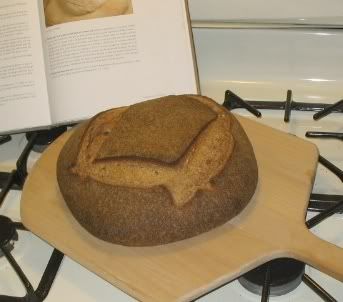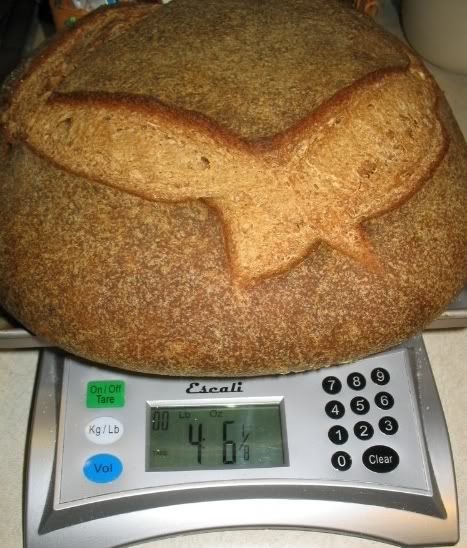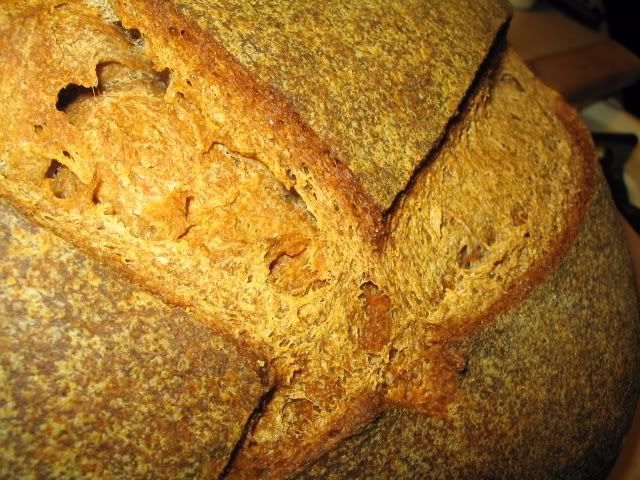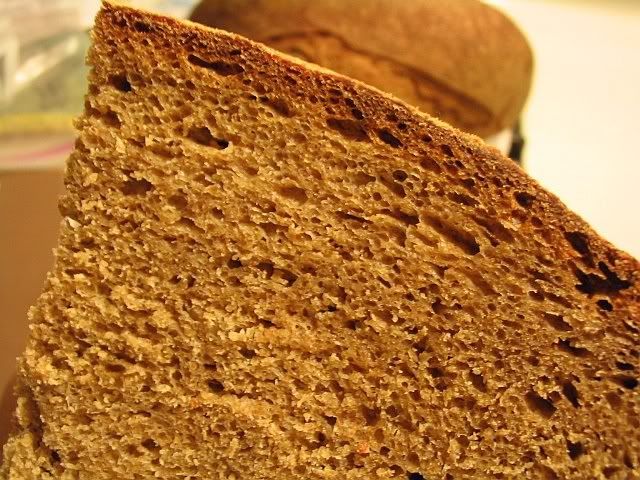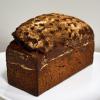I have to start off by saying that this was a very rewarding learning experience and I hope to be able to articulate some of what I learned by making this miche.
So I had a weak moment on Amazon a few weeks back and ordered Reinhart's BBA and Whole Grains books as I've been wanting them for two Christmas' and a birthday but my wife and family never seemed to get the blatant hints. I read BBA first as here at The Fresh Loaf it is considered gospel. I found it to be a well put together, well thought out, easy to read book. Peter Reinhart's teaching style comes through very well and he made concepts like bakers percentages make sense to me after I'd read and had time to digest them.
Day 1: I started out three days ago by making a hardball pre-ferment with KA Whole Wheat flour sifted through a fine mesh strainer, sourdough starter, and a little filtered water. The hardball sat covered in a lightly oiled bowl for 4-5 hours at room temperature before I put it in the refrigerator to retard for the night.
Day 2: The next afternoon I mixed up the main dough by warming my hardball, sifting TWO POUNDS of KA Whole Wheat flour, incorporating that with the hardball and some water and salt. I mixed the dough and kneaded this behemoth for 10-15 minutes the stashed it in a large covered bowl to let it rest and rise. The dough was left covered at room temperature for around 5 hours during which it doubled in size nicely. Back to the refrigerator for the dough to retard overnight.
Lesson number one was learned here. I had never tried to hand-knead that much dough. Frankly I'm a slave to my KitchenAid but this was just too much dough for it to handle. I used a technique I learned from this site. Once I found it difficult to knead anymore I let the dough rest covered for five minutes. After it rested it was very pliable and able to be kneaded again.
Day 3: I hurried home from work to warm the dough enough so I could shape and bake it. I shaped the miche (large ball/boule) and let it rise on a bed of corn meal on my counter. Once it rose sufficiently I slashed it then used my SuperPeel to scoop it up off the counter and deposit it in my preheated, 500 degree oven on my baking stone. Two temperature changes, one 180 degree rotation and 70 minutes later I removed my first miche from the oven. Internal temp reached 208 degrees F and it thumped nice and hollow.
Lesson number two was that the SuperPeel did a good job picking up this large ball however it stretched it lengthwise a bit more than I'd have liked it to. It may be that I'm just new to the way it works and once I develop better technique I'll not have the same issue. Not a horrible thing but I think I'll stick to parchment and a regular peel for freeform loaves and leave the SuperPeel for pizzas.
This morning I could hardly wait to slice into it and examine the crumb and taste the bread. I thumped it again and it had resonance like a drum. I cut the loaf in half and inhaled deeply. I'd love to hear from others about this but it had the aroma of unsweetened cocoa powder! Two friends that received 1/4 of the loaf both smelled it too. It didn't taste like cocoa and I guarantee there was none in there. It was very strange indeed. While I'm sure this doesn't rival anything coming out of the Poilâne bakery in France it is my most successful whole wheat loaf to date, not to mention the largest. The crumb was tight but not dense, and creamy in consistency. The crust was thick and crisp and wonderful. I'm not sure I'd make this as a miche again but I can see myself making a 2 or 3 boule run of this bread. It was a lot of work to be sure but it was worth it.
Now, here come the pictures.
